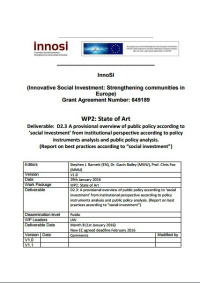The State of the Art of Social Investment
This report is a snapshot of the state of play in 2015 of the ways in which welfare states are moving towards social investment approaches and the extent to which these developments are being impacted by EU policy and funding. InnoSI takes a special interest in a community/citizen-led, bottom-up (including social economy organisations and private companies) approaches to social investment, rather than a government-led top-down perspective. This not of course a binary distinction: governments may involve non-State actors in welfare state reforms and in turn non-State actors may pilot reforms themselves, which are then adopted by governments.
If this report is to identify innovative and strategic approaches to social investments then definitions of those terms are necessary. InnoSI has adopted a working definition of Social Investment from the Social Investment Package (SIP) in full knowledge that social investment is an emerging rather than a fully formed paradigm: “The social investment approach stresses the case for considering certain parts of employment and social policies — and possibly other policy areas, such as education — as entailing investments improving prospects for future employment and social participation, together with more social cohesion and stability … thus stressing the life course dimension of social policies and their long-term benefits for society.” (European Commission 2013a p. 3)
According to the authors of the European Social Policy Network (ESPN) study, “social investment spending has been contrasted with ‘social consumption’ (or compensatory spending), consisting of old-age protection and passive labour market policies.”
To access the full report click on the following link: http://innosi.eu/wp-content/uploads/2016/04/InnoSI-Deliverable-D2-3.pdf


